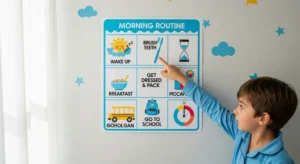If you’re a mom who feels like you’re constantly racing against the clock every morning, you’re not alone. Between getting the kids ready, packing lunches, finding missing shoes, and trying to look somewhat presentable yourself, mornings can feel like an Olympic sport you never trained for. The good news? With the right morning routines, you can transform those chaotic mornings into manageable, even peaceful, starts to your day.
Why Morning Routines Matter for Busy Moms
Before diving into specific routines, it’s important to understand why having a structured morning matters. According to research from the American Psychological Association, establishing daily routines can significantly reduce stress and anxiety levels. For moms juggling multiple responsibilities, this stress reduction isn’t just a luxury — it’s essential for maintaining your mental health and being present for your family.
Morning routines create predictability in an otherwise unpredictable day. When you have a system in place, you spend less mental energy deciding what to do next and more energy actually doing it. This efficiency is what transforms a mom who’s always running late into one who has time to breathe before leaving the house.
The Night-Before Preparation Routine
The secret to winning your mornings actually starts the night before. This routine is about setting yourself up for success while you sleep. Spend 15 to 20 minutes each evening preparing for the next day, and you’ll be amazed at how much smoother your mornings become.
What to Prepare the Night Before
Start by laying out everyone’s clothes for the next day. Yes, everyone — including yours. This eliminates the morning wardrobe crisis when your daughter suddenly hates every shirt she owns or your son can’t find matching socks. Place outfits in designated spots, whether that’s on a chair, in labeled bins, or hanging on door hooks.
Next, pack lunches and prepare breakfast items. You don’t need to make entire meals, but having lunch boxes packed and breakfast ingredients ready to go saves precious minutes. If your kids take packed lunches to school, healthy meal planning the night before ensures better nutritional choices too.
Finally, create a launch pad near your door. This is a designated spot where backpacks, keys, shoes, and anything else needed for the next day lives. When everything has a home, you’ll stop playing the frantic morning scavenger hunt.
The Early Riser Routine
This routine requires waking up 30 to 45 minutes before your kids. I know — the idea of less sleep sounds terrible. But hear me out: this quiet time before the chaos begins is transformative. You get to shower, drink coffee while it’s hot, and mentally prepare for the day without someone asking for a snack every five minutes.
Making Early Rising Sustainable
The key to maintaining this routine is going to bed earlier. You can’t rob yourself of sleep and expect it to work long-term. Set a realistic bedtime that allows for seven to eight hours of sleep. Use that evening routine to wind down properly — limit screen time, read a book, or do some light stretching.
During your quiet morning time, focus on yourself first. Take a proper shower, get dressed, and maybe do some light exercise or meditation. According to Mayo Clinic research, even brief morning movement can boost your mood and energy levels throughout the day.
The Time-Blocked Morning Routine
Time-blocking transforms your morning from a chaotic free-for-all into a well-choreographed dance. This routine assigns specific time slots to each morning task, creating clear expectations for both you and your kids.
Creating Your Time Blocks
Start by working backward from your departure time. If you need to leave by 8:00 AM, map out everything that needs to happen before then. Wake up at 6:30 AM, kids up by 7:00 AM, breakfast by 7:15 AM, dressed by 7:30 AM, teeth brushed by 7:45 AM, and shoes on by 7:50 AM.
The magic happens when you communicate these time blocks to your kids. Use visual timers or colorful charts that show what should be happening when. Children thrive on routine and predictability, and time-blocking provides exactly that. You might be surprised how much more cooperative they become when they know what’s expected.
Build in buffer time — things will go wrong, and that’s okay. If you have a five-minute cushion between activities, a minor meltdown won’t derail your entire morning.
The Simplified Choice Routine
Decision fatigue is real, and mornings are full of decisions. This routine minimizes choices to streamline your morning. The fewer decisions you and your kids need to make, the faster things move.
Implementing the Simplified System
Create a rotating breakfast menu — maybe Monday is always oatmeal, Tuesday is yogurt and fruit, Wednesday is eggs, and so on. Your kids might initially protest, but the consistency removes the daily negotiation about what’s for breakfast.
Limit clothing choices by having a capsule wardrobe approach. Keep only clothes that fit, are seasonally appropriate, and that your kids actually like wearing. When everything in the closet is a viable option, getting dressed becomes simpler.
Apply this same principle to other morning decisions. Use the same backpack spot, the same morning playlist, the same shoe-tying location. These small consistencies add up to significant time savings.
The Team Effort Routine
This routine recognizes that you don’t have to do everything yourself. Even young children can participate in morning responsibilities, and involving them creates life skills while lightening your load.
Age-Appropriate Morning Responsibilities
For toddlers and preschoolers, start simple. They can put their pajamas in the hamper, help choose between two pre-selected outfits, and carry their small backpack to the door. These tiny tasks build independence and pride.
Elementary-aged kids can handle much more — making their bed, preparing their own breakfast with supervision, packing their backpack, and even helping younger siblings with tasks. Create a morning checklist they can follow independently.
For older kids and teens, the expectations should increase accordingly. They should manage their entire morning routine with minimal oversight. This preparation is invaluable for their future independence and gives you bandwidth to focus on younger children or yourself.
The team effort routine works best when you have a family meeting to discuss everyone’s roles. Let kids have input on their responsibilities — ownership increases compliance. Post the agreed-upon responsibilities somewhere visible and celebrate successes together.
Making Your Morning Routine Stick
Implementing any new routine takes time and patience. Research suggests it takes an average of 66 days to form a new habit, so don’t expect perfection immediately. Start with one routine that addresses your biggest morning pain point and build from there.
Remember that flexibility is important too. Some mornings will still be chaotic despite your best efforts, and that’s completely normal. The goal isn’t perfection — it’s progress. Even implementing one or two of these routines will create noticeable improvements in your morning stress levels.
Being a mom who’s constantly running late doesn’t have to be your identity. With intentional morning routines, you can reclaim those early hours and start your day feeling capable, calm, and ready for whatever comes your way. Your future, on-time self will thank you.




